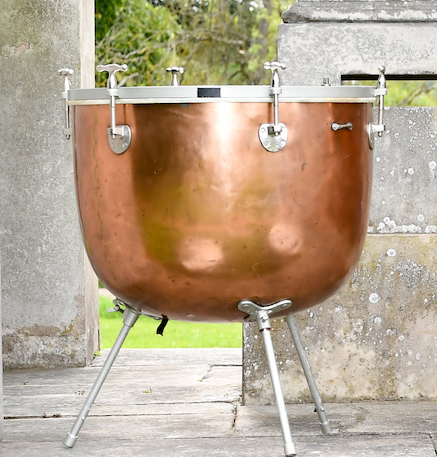


These timpani were popular in Britain at the start of the 20th century. Here is a photo of Elgar conducting the London Symphony Orchestra at the Queen’s Hall in 1911 just a year before their famous ground-breaking trip to New York. The timpani in the photo appear to be very similar indeed to my Hawkes drums.

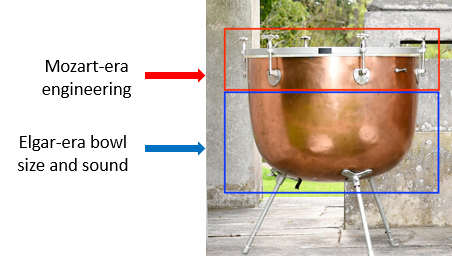
These drums are hybrids. Although smoother and slicker the tuning system uses essentially the same engineering as in Mozart’s time.

Hawkes early 20th Century timpani
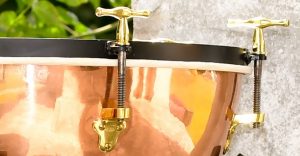
Potters cavalry timpani
But surely what matters is what the drums sound like? The major difference is that the bowls have been made deeper to increase the decay and maximum volume. Also permanent built-in legs have been added.
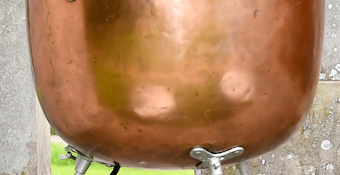
Hawkes early 20th Century timpani

Potters cavalry timpani
Unfortunately the collars remain small as per earlier drums but due to the volume of the kettle thinner heads work well providing a purer, more modern sound with longer decay.
And so although orchestration and timpani techniques had advanced significantly in 200 years, Elgar was restricted in his options to write harmonically (as timpani parts were becoming by 1900) due to the primitive tuning system. In all his parts one can see where choices have had to be made where, for example, some notes were replaced by ‘less-than-ideal’ ones or left out altogether. Something that one cannot say about all composers; Elgar certainly understood the limitations of the instruments at his disposal and his writing is still dramatic but intelligent to work within these immovable limits.
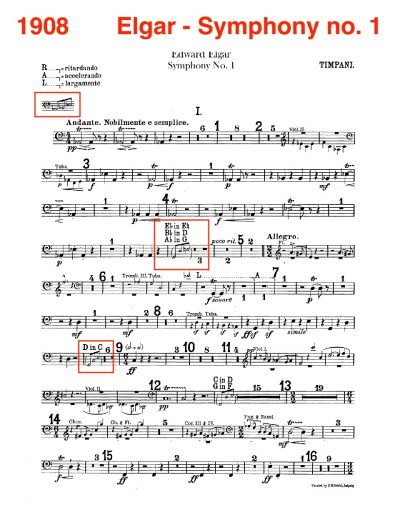
Not just limited by the tuning system Elgar most often seems to write as if the player only has three drums. Although this is undoubtedly restricting there is one major and shrewd advantage in that writing for small, realistic forces means that your music is more likely to be played more often by amateur and youth orchestras.
The tuning changes in Elgar’s 1st Symphony are very similar in in speed and difficulty to the tricky quick changes Mozart writes in the Act II Finale of Cosi fan Tutte.
It is interesting to compare Elgar to what Richard Strauss was writing for timpani at the same time.
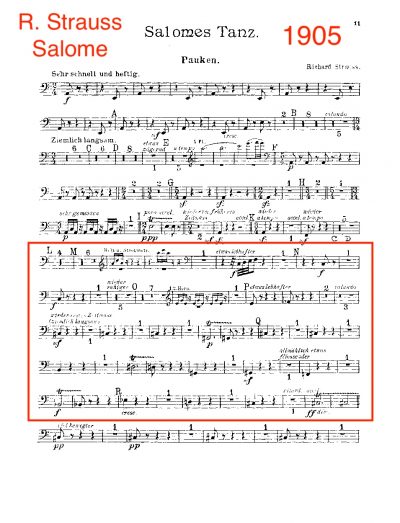
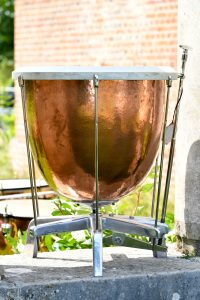 Probably inspired by the new fast-tuning single crank timpani, the writing in Strauss’ operas (including Salome, Der Rosenkavalier, Elektra and Die Frau ohne Schatten) was radical and ambitious, the proof of that being that they are today still amongst the most technically challenging parts we have to play.
Probably inspired by the new fast-tuning single crank timpani, the writing in Strauss’ operas (including Salome, Der Rosenkavalier, Elektra and Die Frau ohne Schatten) was radical and ambitious, the proof of that being that they are today still amongst the most technically challenging parts we have to play.
Utterly different to Elgar here the timpanist must find 12 different pitches in a section that lasts just a couple of minutes. And another huge difference to Elgar; Strauss must surely have been aware that through his enormous orchestration (including such unusual instruments as the heckelphone) and fiendish technical demands that many of his larger works would only be performed by the largest and most elite orchestras and opera companies.
So… are these deep English hand-tuned timpani any good? Well, some would quickly say no. In some ways they are the worst of both worlds, definitely possessing the most primitive tuning system of all the available types of large-bowl timpani ruling out their use for certain repertoire as we see above. Or to put it a completely different way; although the tuning system and relatively small collars suit earlier repertoire the bowls are far too big for smaller ensembles playing this music.
On the other hand, unless you are playing complicated tuning repertoire these timpani are perfectly good for most repertoire with a reasonably large orchestra. Compared to pedal or single-crank drums they are much more portable and robust and very much more affordable. With the use of small gels in the middle of the heads some excess decay can be taken away for smaller ensembles playing earlier repertoire and/or when playing in big acoustics. Due the need to match the resonance of the bowl with the resonance of the head (note; the small collar is ‘out of sync’ with this), this explains the need (as I said earlier) to use thin modern heads. And so while gels reduce decay and volume and clever stick choices can be made, deep drums with thin heads can never achieve a proper baroque or classical attack or sound.